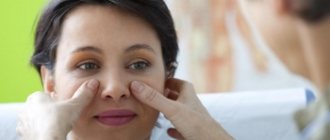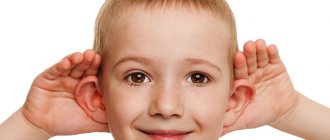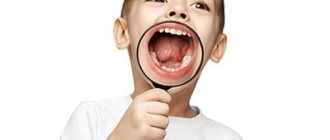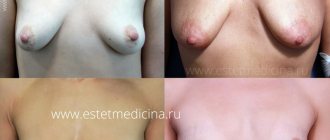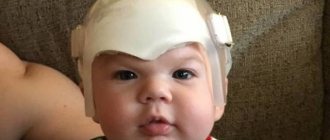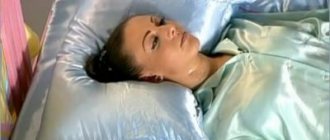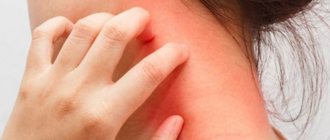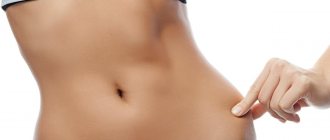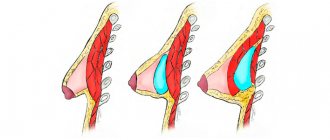A sloping nape in a child is a very worrying topic for parents because... Visually, this shape of a newborn’s head looks unpleasant, and many people think that the brain may be shrinking, etc. mom's fears. In fact, children are clearly not bothered by this head shape, but there is another, bad feature: with a sloping head, the child lies on his back with the flattened part of his head against the mattress, and it is very difficult for him to turn his head in such a situation. Due to the predominantly turned head when the child is lying on his back, firstly, the flattening of the back of the head becomes even stronger, and secondly, the muscles, ligaments, and joints of the neck get used to turning the head in one direction, and turning it in the other becomes even more difficult, because the musculoskeletal system is used to it. Often, the sloping back of the head in an infant and the habitual turn of the head develop in parallel, and are mutually reinforcing factors.
The reason for the formation of a sloping nape in a baby
1. The main reason, of course, is the head lying for a long time with a turn in one direction. In newborn children, the bones contain a lot of cartilage, and therefore they are soft and not very, but still easily deformed under the prolonged influence of gravity of the body itself or other mechanical influence. The key word here is “long-term”; it is because of prolonged pressure on the bones of the skull that deformation of the back of the head occurs in infants, and of course, the age-related characteristics of the “softness” of the children’s skeleton play a role. 2. There is also a reason for the head to constantly lie turned only in one direction. More often, this position of the head is ensured by the motor apparatus of the neck and head, which in newborns very often works asymmetrically due to injuries during childbirth, such as torticollis.
Can an osteopath help adults?
Modern cranial-sacral techniques used by osteopaths when working with newborns are quite effective in correcting the skull in adult patients. Of course, the mobility of the bones of the skull after 6-7 years is significantly reduced, but some parts of it do not ossify until 10 years, and they retain mobility even longer - up to 25 years. All this allows you to optimize the geometry of the head, achieving not only aesthetic perfection, but also the elimination of various dysfunctions, the causes of which osteopathy sees precisely in the distortion and blocking of the bones of the skull.
What else should you pay attention to?
Deformation of the back of the head can be not only oblique (this is only when the head is turned), but also in the frontal plane. This is possible with rickets, or the inability to turn the head. Tight cocoons, cribs, cradles are not the best place for a child. Try sleeping all night in one position yourself. Increased attention to the case of rickets, because in this case, deformations form faster. The most dangerous period for the formation of a sloping nape is up to 3 months of age. Children older than three months usually lie on their stomach or side more often, move more, roll from side to side, having learned to roll over from back to stomach, they regulate their position, i.e. the head does not lie in one place for a long time.
Help from an osteopath in correcting the shape of the head in newborns
Many parents are in no hurry to seek help from an osteopath, trusting the methods of traditional medicine. Unfortunately, in that part that concerns the shape of the baby’s skull, it manifests itself in a symptomatic approach, which is not effective enough and does not treat the root cause of the disorders. The osteopath acts on areas of the child’s head, using subtle manual (in particular, cranial) techniques, characterized by delicacy and a narrow focus of influence.
Treatment by an osteopath can take a long time - it all depends on the time of treatment and the nature of the disorders:
- Up to 3 months. The best period is when a competent program for correcting the shape of the skull allows you to eliminate any violations, due to the fact that all the fontanelles are still open in the baby, and the interosseous sutures are plastic and large;
- From 3 to 6 months. At this age, corrective therapy is also quite effective, but takes longer due to the closure of some of the fontanelles;
- From 6 to 12 months. At this age, all the fontanelles in the child close, except for the large one, but the occipital bone has not yet fused, so there are still certain possibilities for correcting the head and eliminating asymmetry, although they are significantly less than at an earlier age;
- From 1 to 3 years. At this age, the help of an osteopath is still effective and quite effective, but it is largely aimed at eliminating dysfunctions caused by an irregular head shape. It is already quite difficult to correct the geometry of the skull at this stage, but it is possible, especially with regular sessions.
How to correct a sloping nape in a child?
In newborns aged 1-2 months, it is important to monitor the position of the head, especially if the child begins to like to look in one direction. At such an early age, children do not have much strength to turn their heads often, so you can help them. 1. Having noticed such a picture in your baby, do an exercise in the form of fixing the child’s head by turning it in the opposite direction than usual, and holding it for several minutes, several times a day. This exercise is to get the muscles and ligaments of the neck used to working in the other direction. With such fixation for several minutes, the obliquity of the back of the head is not corrected quickly, but it must be done so that the child can then turn his head normally on his own. 2. One of the auxiliary options is a children's orthopedic pillow with a notch in the middle. The pillow helps the child keep his head straighter. This method can be used during daytime sleep. But control is needed, because the child may spit up. 3. The most important and reliable way to correct a child’s sloping head is his physical development. If the child moves a lot, lies on his stomach, sits, crawls, stands on his feet, then under the influence of gravity the sloping head will straighten itself. The brain, with the head in a vertical position, will exert pressure on the walls of the skull from the inside, thereby leveling (squeezing out) and rounding the flattened bones of the skull. This does not happen very quickly, but it is the only way to realign the bone from inside the skull.
Features of the structure of the newborn’s skull
In a newborn, the skull is not a monolithic bone. However, it is not like this in an adult either, but after 6 years the mobility of the bones that make up the skull is very limited, so it is so important to monitor the changes and, if necessary, correct the shape of the skull starting from the first days of the child’s life.
The baby’s head consists of two main parts - the arch, which at an early stage of life (up to 6 years), is also composite, and the base, which is formed from cartilaginous tissue and ossifies with age. The cranial vault in newborns consists of 4 parts connected by movable lamellar tissue. Over time, these parts come closer to each other and ossify in adulthood, forming a structure that is practically motionless relative to each other.
Will massage help a baby with a sloping head?
Sometimes people ask me, if a baby has a sloping head, what should they do, what kind of massage would you recommend. But massage does not play the first role in the treatment of a sloping nape in an infant, and this problem cannot be corrected by massage itself. Massage will not be able to bend the bone, even though it is soft. With the help of massage, we make the child more mobile, and mobility is already the most important healing factor for this problem. It is the prolonged lying of a child with an unevenly fixed head that most often leads to the formation of a slanted, flattened head. Therefore, massage for a child with a beveled head is aimed specifically at general physical development, in which the baby will not lie in one position for a long time, but will constantly move. In this way, the harmful factor is minimized and the beneficial factor is increased.
The importance of head shape and possible complications
Osteopathy attaches great importance to the shape of the skull, since it is the correct arrangement of the bones and its components that determines the balance of the membranous membranes of the brain and the possibility of its micropulsations. Due to the distortion of the geometry of the head, disturbances in the blood supply to the brain can be observed, which negatively affects not only the brain itself, causing the death of nerve cells, atrophy of part of the cortex, but also the organs for which this part of the brain is responsible for their work and interaction.
Possible complications arising from disturbances in the geometry of the cranium:
- Frequent otitis media, which are difficult to treat and often have relapses;
- Impaired hearing, vision, smell, taste. They can manifest themselves to varying degrees and be combined with each other;
- Frequent colds, runny nose, allergic reactions to flowering;
- Problems with appetite, abdominal pain, indigestion and stool disorders;
- Development of malocclusion, dental problems;
- Irritability, nervousness, poor sleep;
- Mental development disorders. School-age children may also develop absent-mindedness syndrome, learning delays, minimal brain dysfunction, etc.
The aesthetic component is also important. Violation of the geometry of the cranium, asymmetry is reflected in the child’s face. This is not only unsightly in itself, but can also cause psychological trauma as you grow older.
Timely help from an osteopath allows you to eliminate the disturbances, restoring the normal geometry of the cranium, which also allows you to restore the lost equilibrium position of the meninges and normalize blood circulation. Broken nerve connections are restored or replaced with new ones, which leads to the elimination of brain dysfunctions and prevents possible problems with other organs and parts of the body.
Prevention of the formation of a sloping head in children.
While the child is small, 1-2 months old, it is advisable for him to do at least a little gymnastics, and regularly. Rolls from back to stomach, turns to the side, movements of the limbs, turns of the head to the right and left up to 90 degrees (so that the cheek lies parallel to the surface on which the child is lying). The baby needs to change his position in the crib, i.e. turn it with your head, one day it lies in one direction, the next day in the other. This is so that the baby, when he pays attention to sounds, people, lights, turns his head towards them, every day in a different direction. Also, lying on your side and stomach is very useful; with such poses, a sloping neck does not occur.
Why does your face change after wearing braces?
The principle of operation of the braces system is that it gradually and forcibly moves the teeth in the required direction. Thanks to this process, you can correct the profile, correct the anomaly of an individual tooth or a whole row, and improve facial aesthetics. Already 8 months after wearing braces, the patient can notice how his face changes after braces.
Why do transformations occur?
- - increased tension, lengthening of ligaments;
- - decrease or increase in muscle tone;
- — transformation of bone tissue;
- - changes affecting subcutaneous tissue, fascia and the skin itself;
- — visual visibility of the bracket system itself.
The maxillofacial region is a single anatomical and functional system. If something changes in the bone structure, it is reflected in a person’s facial features. However, you should not assume that the changes will be as noticeable as after plastic surgery. In some patients, the transformation is practically not expressed, while in others it is too noticeable. Let us repeat that this is due to the nature and extent of the anomaly. At the initial consultation, our orthodontist will tell you about the features that may occur with your face, whether your face changes after wearing braces, and whether this may affect your particular case.
Transformations may also be due to the fact that the patient is forced to comply with certain dietary restrictions. In this regard, the face loses weight and the effect of “sunken” cheeks appears.
Earfold implants
The latest solution at the intersection of surgery and conservative treatment methods. This is a minimally invasive alternative to surgery that provides good cosmetic results. The patented technique allows you to remove protruding ears, provided that the implants are constantly worn. Elimination of protruding ears is based on the fact that special mini-implants several millimeters in size are implanted into the ears. With their help, the cartilage is gradually rebuilt, the shape of the ear changes, and a correction effect is achieved. EarFolds are biocompatible, so there is no need to get rid of them in the future.
How are implants designed?
Each implant is a thin curved metal plate made of an alloy based on nickel and titanium, coated with medical gold. Thanks to this composition, biological compatibility is achieved, which is important because products for correcting protrusion must be located under the skin.
How to get rid of protruding ears using earfold?
The implantation procedure is carried out under local anesthesia and takes 20-30 minutes. Before it, precise positioning is carried out on an individual basis. Through an incision of about 1 cm, the implant is inserted under the skin and takes the desired shape, fixing the cartilage in the correct position. After this, two stitches are applied. The product holds the ear in the desired position.
So far, this technique is not very widespread, and the products themselves are expensive.
How to improve your facial profile or The dependence of facial aesthetics on the position of your teeth
All patients who consult an orthodontist know how the position of teeth determines the aesthetics of a smile, but many do not even suspect that the position of the teeth also determines the profile of the face.
To understand how orthodontic treatment affects changes in facial profile, let's look at the types of profiles.
Types of Face Profiles
- Straight
- Convex
- Concave
Orthodontists usually use a conditional “profile line”
. This is the line that runs through the most prominent point of the chin and upper/lower lip. The relationship of this line to the nose is assessed.
Racial characteristics must be taken into account here.
Fine:
- for representatives of the Caucasian race, the profile line should pass through the middle of the nose
- in representatives of the Mongoloid race this line touches the tip of the nose
- in representatives of the Negroid race it does not reach the tip of the nose
How to determine your profile type at home?
Take a long ruler and place it edge-on to your chin. Maintaining contact at this point, bring the ruler closer to your face until it touches one of your lips (you may have to tilt the ruler slightly away from your nose to do this). Ask someone to take a photo (or take a selfie) of you in profile.
Rate the profile based on your photo:
- Does the ruler go through the middle of the nose? You have a harmonious/straight profile.
- Does the ruler touch the tip or not even reach your nose? You have a convex profile type.
- Does the ruler go through the base of the nose or does it extend onto the face? You are the owner of a concave profile.
Of course, it is worth making allowances for individual characteristics, such as the shape and size of the nose, lips, and, as already mentioned, race.
Possibilities of orthodontic treatment in improving facial profile.
As a rule, each type of profile corresponds to a certain type of bite and a certain position of the teeth.
And if there are no questions with the direct/harmonious type of profile, then malocclusions corresponding to (or rather, being the cause of) the 2nd and 3rd types - convex and concave - require special consideration.
Cause of convex profile
There may be types of bite in which:
1. The lateral teeth close correctly, while the front teeth protrude strongly forward.
Typically, this position of the teeth is corrected by removing the teeth behind the canines and “pushing” the front teeth into the vacant spaces:
| Before | After |
| Before | After |
2. The lower jaw is behind the upper jaw more than normal / the lower jaw is too small
During orthodontic treatment, the lower jaw “comes forward” and the profile improves:
| Before | After |
Concave profile
, as a rule, is a consequence of a bite in which the lower jaw is “in front” of the upper jaw.
Orthodontic treatment helps to cope with the following situation:
| Before | After |
There are cases when it is impossible to cope with orthodontic methods alone, and then orthognathic surgery comes to the rescue:
| Before | After |
The benefits of orthodontics go far beyond just a beautiful smile. Change for the better! We can help you with this.
